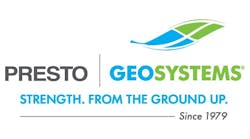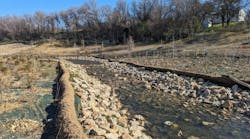Persistent Drainage Problems Necessitate Repair
Such was the case with a channel in Brevard County Florida plagued with flooding after heavy rainfall. Chronic drainage issues along a roadway in West Cocoa were alleviated by incorporating a tiered vegetated GEOWEB geocellular channel system to prevent erosion, allow for higher stormwater volume and mitigate flooding issues.
In searching for an erosion control solution, Engineers Bussen-Mayer Engineering Group, Inc. approached stormwater/erosion control specialists R.H. Moore & Associates, Tampa for ideas for the newly planned channel. The channel design consisted of box culverts as well as open areas to allow for more volume to help alleviate the flooding potential.
Naturally-Vegetated Channel Solution
Various options were considered including gabions, articulating concrete block mats, fabric-formed concrete, and the GEOWEB channel system. Requiring protection from erosive forces, and desiring natural aesthetics, the GEOWEB channel system was ultimately the chosen solution to meet both needs.
Both sides of the channel were stabilized with GEOWEB MSE channel structures—layered GEOWEB sections with geogrid reinforcement. Each layer was designed with a set back to allow for vegetation growth in the open front cells. The overall channel system consisted of Mirafi 2XT reinforcing geogrid and 15,000 square feet of GEOWEB green-fascia wall panels.
How Tiered GEOWEB Channels Work
Multi-layered geocellular channels are designed as flexible wall structures with steep banks and small horizontal footprints. Their narrow profile reduces land use and allows for a high volume of flood storage. Vegetated geocellular channels are designed to withstand high flows for short durations while allowing natural vegetation.
- The flexible nature of geocellular channels allows them to perform well even in soft-soil environments without loss of integrity.
- The corrosion-resistant HDPE material will not degrade with water contact.
- The outer cells are filled with topsoil and vegetation; the back cells filled with a drainable material.
- Where heavier flows are expected, concrete or aggregate/grout in the lower outer cells offers hard-armoring and greater resistance to hydraulic stresses.
- Geocellular channels are highly adaptable to landscape contours and curves.
Months after the Lake Drive installation, the vegetation in the channel is healthy and dense—protecting the channel side slopes from erosion that previously limited stormwater volume and contributed to flooding. With the drainage project completed, the flooding problems on Lake Drive have been eliminated. The project was funded through a grant from the stormwater utility.
Editor's Note: Scranton Gillette Communications and the SGC Water Group are not liable for the accuracy, efficacy and validity of the claims made in this piece. The views expressed in this content do not reflect the position of the editorial teams of Water & Wastes Digest, Water Quality Products and Storm Water Solutions.







